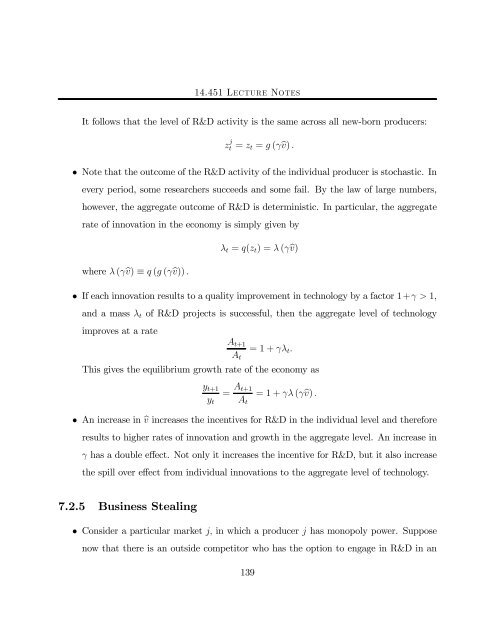14.451 Lecture Notes Economic Growth
14.451 Lecture Notes Economic Growth
14.451 Lecture Notes Economic Growth
Create successful ePaper yourself
Turn your PDF publications into a flip-book with our unique Google optimized e-Paper software.
<strong>14.451</strong> <strong>Lecture</strong> <strong>Notes</strong><br />
It follows that the level of R&D activity is the same across all new-born producers:<br />
z j<br />
t = zt = g (γbv) .<br />
• Note that the outcome of the R&D activity of the individual producer is stochastic. In<br />
every period, some researchers succeeds and some fail. By the law of large numbers,<br />
however, the aggregate outcome of R&D is deterministic. In particular, the aggregate<br />
rate of innovation in the economy is simply given by<br />
where λ (γbv) ≡ q (g (γbv)) .<br />
λt = q(zt) =λ (γbv)<br />
• If each innovation results to a quality improvement in technology by a factor 1+γ>1,<br />
and a mass λt of R&D projects is successful, then the aggregate level of technology<br />
improves at a rate<br />
At+1<br />
At<br />
=1+γλt.<br />
This gives the equilibrium growth rate of the economy as<br />
yt+1<br />
yt<br />
= At+1<br />
At<br />
=1+γλ(γbv) .<br />
• An increase in bv increases the incentives for R&D in the individual level and therefore<br />
results to higher rates of innovation and growth in the aggregate level. An increase in<br />
γ has a double effect. Not only it increases the incentive for R&D, but it also increase<br />
the spill over effect from individual innovations to the aggregate level of technology.<br />
7.2.5 Business Stealing<br />
• Consider a particular market j, in which a producer j has monopoly power. Suppose<br />
now that there is an outside competitor who has the option to engage in R&D in an<br />
139

















